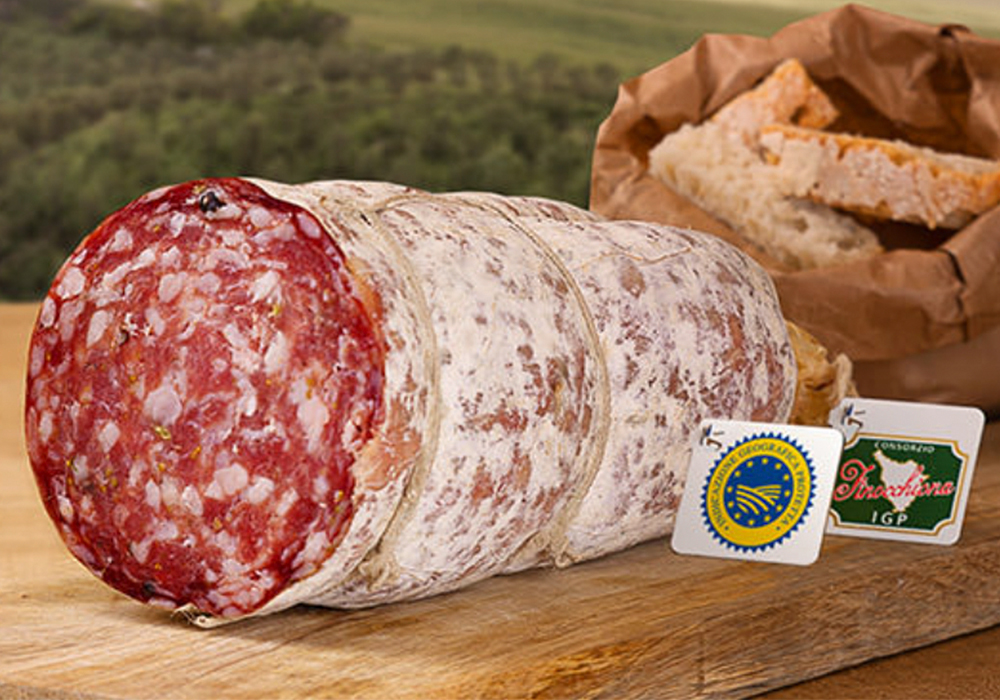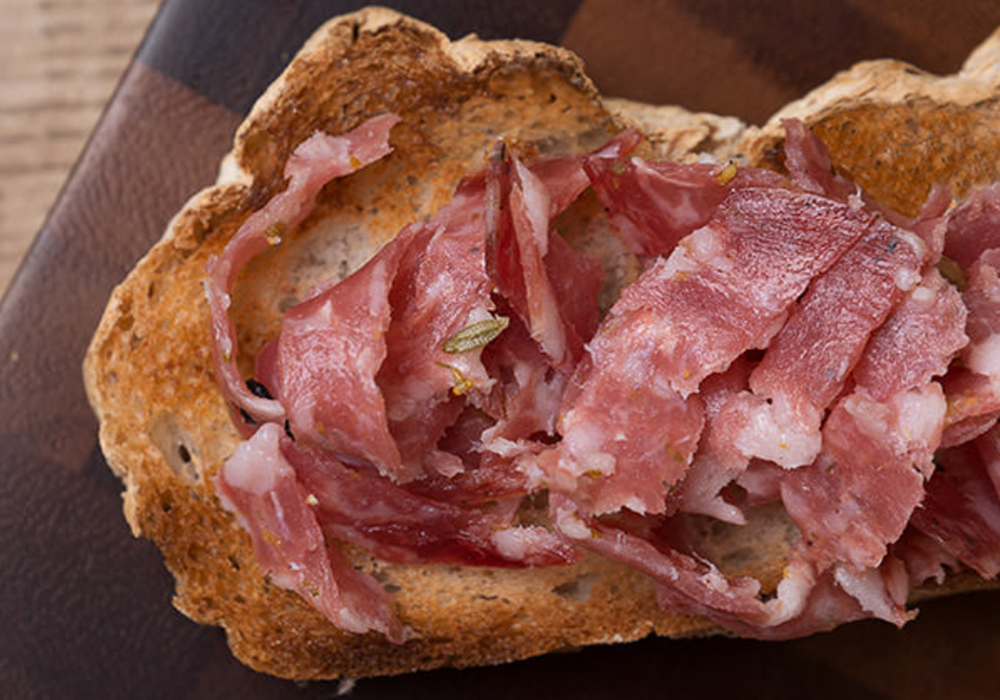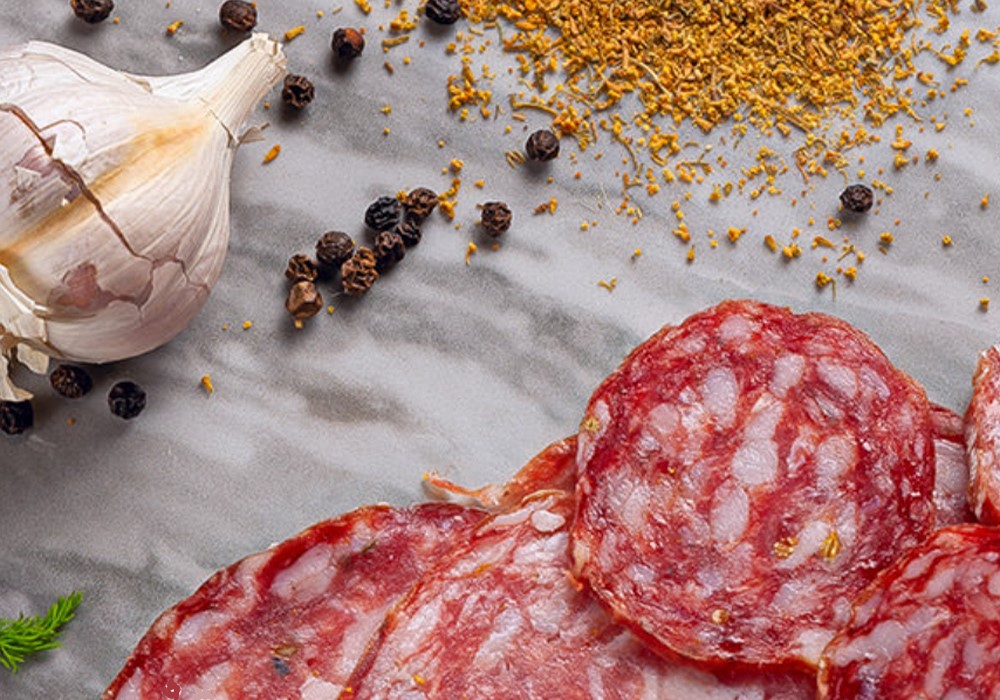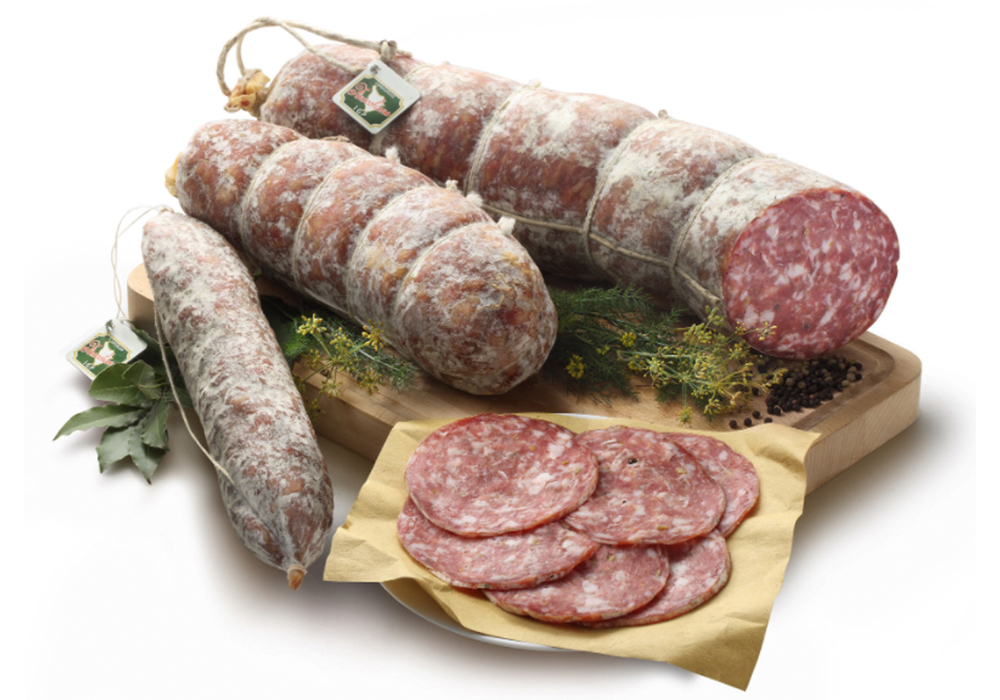
The Finocchiona symbol of Tuscan food tradition
Finocchiona IGP is the most typical Tuscan cure meat with a unique flavour, thanks to the aroma of fennel in seeds and/or flowers in the dough. The combination of the best certified Italian meats and the artisanal recipe gives life to the Finocchiona IGP (Protected Geographical Indication), obligatorily marked "IGP". Finocchiona has a lively red colour, thanks to the red wine mixed with fresh pork meat. Usually, we use Tuscan bread (without salt) with it.
"Just as skilled hairdressers are capable of making even the ugliest woman look attractive, so the aroma of Finocchiona is capable of camouflaging the flavour of even the most undrinkable wine."
Who among the food experts does not know this Tuscan saying of Chianti origin? Probably no one, and from here, we understand the importance that this salami covers in the Florentine territory and throughout Tuscany.

Years ago, wine farmers used the fennel or fennel seeds to cover the faults of the table wine, often of poor quality. From here, you can imagine that both fennel and its seeds are not among the best combinations.
The history of the Finocchiona is long and boasts an ancient tradition and enrich the table of all Italians and not just Tuscans. Its flavour is wild with a fresh taste of fennel and very soft on the palate.
If you have had the opportunity to enter traditional Tuscan shops, you will surely have noticed hanging this superb salami, typical of our gastronomy.
The Finocchiona culture is part of the ancient Tuscan tradition of pork breeding, dating back to the Etruscan-Latin period. The well-known Roman historian Plinio tells us how, in his time, twenty thousand pigs were sent to Rome for slaughter every year from Etruria. Tuscany, then Etruria, was the ideal land for pigs breeding, especially in the Maremma area, marked by vast territories that guaranteed perfect conditions.

But how did such a particular name come about?
To find out, we have to take a step back in time to the Middle Ages, when the butchers (pork processing workers) had to solve the problem of pepper, in that historical period one of the rarest and most expensive spices on the market. It was enough to look around and observe what nature had put at hand, the fennel (in Italian finocchio /fɪˈnɒkɪəu) seeds. The rest is history.
The characteristic taste of Finocchiona immediately conquered the Tuscan tables, even the noblest ones with illustrious characters such as Niccolò Machiavelli, who, as history says, particularly loved this salami, so much to appreciate it at every meal.
From the linguistic point in 1889, the Finocchiona gets the attention of the Accademia della Crusca, which inserts the name in its Vocabulary, emphasizing its link with the Tuscan territory. Finally, in 1956, Treccani gave it formal recognition, with the term Finocchiona gaining its place in the Italian Encyclopaedic Dictionary to underline its importance in the typical Tuscan delight.

Eating a slice is like taking a trip to the most authentic Tuscany to discover its traditions, the lesser-known villages and the most hidden glimpses.
Have you already tasted this magnificent excellence? On our online shop, the most curious may find a version of Finocchiona di Cinta Senese from the union with another Tuscan excellence, the Cinta Senese meat.
The meat of Cinta Senese pork (cinta = belt) owes its name to the white fur belt on the back that surrounds its body, which is dark for the remaining part. The particular aroma of its meat is due to the disciplinary for which it is bred in the wild. An animal that weighs 40-50 kg at a young age weighs up to 300 kg in adulthood.
So, what are you waiting for? For your Finocchiona IGP or Finocchiona with Cinta Senese, just in one click, and you can enjoy it on your table.
Join us on Instagram
"Just as skilled hairdressers are capable of making even the ugliest woman look attractive, so the aroma of Finocchiona is capable of camouflaging the flavour of even the most undrinkable wine."
Who among the food experts does not know this Tuscan saying of Chianti origin? Probably no one, and from here, we understand the importance that this salami covers in the Florentine territory and throughout Tuscany.

Years ago, wine farmers used the fennel or fennel seeds to cover the faults of the table wine, often of poor quality. From here, you can imagine that both fennel and its seeds are not among the best combinations.
The history of the Finocchiona is long and boasts an ancient tradition and enrich the table of all Italians and not just Tuscans. Its flavour is wild with a fresh taste of fennel and very soft on the palate.
If you have had the opportunity to enter traditional Tuscan shops, you will surely have noticed hanging this superb salami, typical of our gastronomy.
The Finocchiona culture is part of the ancient Tuscan tradition of pork breeding, dating back to the Etruscan-Latin period. The well-known Roman historian Plinio tells us how, in his time, twenty thousand pigs were sent to Rome for slaughter every year from Etruria. Tuscany, then Etruria, was the ideal land for pigs breeding, especially in the Maremma area, marked by vast territories that guaranteed perfect conditions.

But how did such a particular name come about?
To find out, we have to take a step back in time to the Middle Ages, when the butchers (pork processing workers) had to solve the problem of pepper, in that historical period one of the rarest and most expensive spices on the market. It was enough to look around and observe what nature had put at hand, the fennel (in Italian finocchio /fɪˈnɒkɪəu) seeds. The rest is history.
The characteristic taste of Finocchiona immediately conquered the Tuscan tables, even the noblest ones with illustrious characters such as Niccolò Machiavelli, who, as history says, particularly loved this salami, so much to appreciate it at every meal.
From the linguistic point in 1889, the Finocchiona gets the attention of the Accademia della Crusca, which inserts the name in its Vocabulary, emphasizing its link with the Tuscan territory. Finally, in 1956, Treccani gave it formal recognition, with the term Finocchiona gaining its place in the Italian Encyclopaedic Dictionary to underline its importance in the typical Tuscan delight.

Eating a slice is like taking a trip to the most authentic Tuscany to discover its traditions, the lesser-known villages and the most hidden glimpses.
Have you already tasted this magnificent excellence? On our online shop, the most curious may find a version of Finocchiona di Cinta Senese from the union with another Tuscan excellence, the Cinta Senese meat.
The meat of Cinta Senese pork (cinta = belt) owes its name to the white fur belt on the back that surrounds its body, which is dark for the remaining part. The particular aroma of its meat is due to the disciplinary for which it is bred in the wild. An animal that weighs 40-50 kg at a young age weighs up to 300 kg in adulthood.
So, what are you waiting for? For your Finocchiona IGP or Finocchiona with Cinta Senese, just in one click, and you can enjoy it on your table.
Join us on Instagram
Share on:
Powered & Designed by Passepartout


